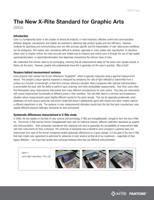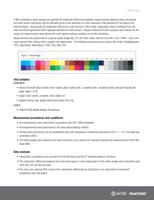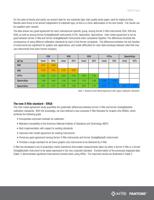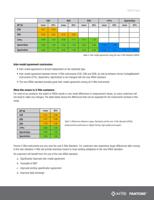
White Paper
The New X-Rite Standard for Graphic Arts
(XRGA)
Introduction
Color is a fundamental factor in the creation of almost all products. In most industries, effective control and communication
between designer, manufacturer and retailer are essential to obtaining high product quality and cost efficiency. However,
methods for specifying and communicating color are often process-specific and the interpretation of color data across workflows
can be ambiguous. This makes color consistency difficult to achieve, especially in cross-media color reproduction. In industries
where color is mission-critical, the most accurate and reliable way to measure and control color is through the use of high quality
spectrophotometers- or spectrodensitometers that objectively characterize the intrinsic value of color.
We understand this intrinsic value to be unchanging, meaning that all measurements taken for the same color sample should, in
theory, be the same. However, graphic arts professionals know this is generally not the case in practice. Why is that?
Reasons behind measurement variance
Every physical color sample has its own reflectance “fingerprint”, which is typically measured using a spectral measurement
device. The sample’s unique spectral response is measured by comparing the ratio of light reflected or transmitted from a
surface as a function of wavelength, to that from a known reference standard. Many companies offer spectral instrumentation
to accomplish this task, with the ability to perform spot, scanning, and inline (embedded) measurements. Over time, users often
find themselves using measurement instruments from many different manufacturers for color control. They also use instruments
with varied measurement functionality at different points in their workflow. This will often lead to a common and troublesome
situation where measurements report slightly different results for the same sample. This can be especially problematic when
databases are built using a particular instrument model that doesn’t satisfactorily agree with results from other models used by
a different department or site. The variance in color measurements ultimately results from the fact that each manufacturer uses
slightly different physical calibration standards for their instruments.
Systematic differences characterized in X-Rite study
In 2006, the two leaders in the field of color science and technology, X-Rite and GretagMacbeth, merged to form the new X-Rite,
Inc. The former X-Rite and the former GretagMacbeth each had, for historical reasons, different calibration standards for graphic
arts instrumentation. Both companies maintained their standard over time to guarantee the compatibility of measurement data
with their instruments for their customers. The continuity of standards was a benefit to each company’s customer base, but
instruments from each of the former companies exhibit systematic differences on a given sample. It is the goal of the new X-Rite
that inter-model color agreement is optimized for advances in color science so that all of our customers – regardless of their
legacy affiliation - can enjoy high quality data exchange between sites that use different instrumentation.
Figure 1:
Left to Right: SpectroEye, i1Pro, 530





